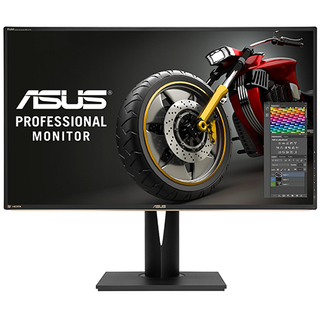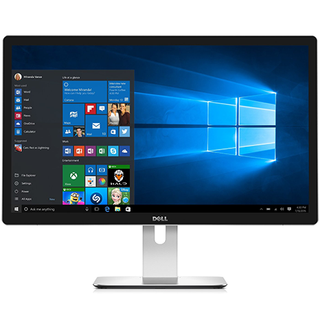Dell UP3017 30-inch 16:10 Professional Monitor Review
Why you can trust Tom's Hardware
Brightness & Contrast
To read about our monitor tests in depth, please check out Display Testing Explained: How We Test Monitors and TVs. Brightness and Contrast testing is covered on page two.
Uncalibrated – Maximum Backlight Level
Our most recent reviews of professional displays include the 5K screens from Dell (UP2715K) and HP (Z27q). We also have the NEC PA302W 16:10 monitor. Rounding out the group are Asus PA329Q and BenQ SW2700PT. All products use IPS panels and feature both Adobe RGB and sRGB gamut options.



Proofing monitors don’t need a ton of output but all here provide at least 300cd/m2. The UP3017 measures just under its claim of 350cd/m2. You'd have no issues using it at an outdoor location if necessary.
Black level is near the top of the group in the max backlight test. IPS isn’t known for tremendous contrast, but when a screen tops 1000:1 in our benchmark, we are satisfied. Among professional displays, it’s slightly above the norm. Given its accuracy in all our color and gamma measurements, the image quality is quite excellent.
Uncalibrated – Minimum Backlight Level



The minimum white level dips a bit below our 50cd/m2 preference. Set the brightness slider to 5 for that output. Black levels and contrast remain consistent throughout the backlight’s operating range. Our only minor complaint is the wide gap between maximum and minimum means a somewhat coarse resolution for the 100-step brightness control. Each click is around 3cd/m2.
After Calibration to 200cd/m2



In the UP3017’s case, calibration simply means setting the brightness to 200cd/m2 so we can provide a fair comparison to the other displays. No other adjustments were performed in any of the image modes. This is the very consistent performance one should expect from a pro-grade monitor.
We’re also showing the effect of the uniformity compensation that we used in the Standard preset. It operates mostly on the brighter steps and reduces output by 20% and contrast by 34%. You can judge for yourself whether its effectiveness is worthwhile by reading our uniformity results on page five.
ANSI Contrast Ratio

ANSI contrast is fairly solid at 956.7:1; a 9% drop from the sequential value. The uniformity compensation lowers the overall white level but has little effect on black, which explains the lower ANSI number. Our sample has a good-quality panel with solid intra-image contrast.
Current page: Brightness & Contrast
Prev Page OSD Setup & Calibration Next Page Grayscale, Gamma & ColorStay on the Cutting Edge
Join the experts who read Tom's Hardware for the inside track on enthusiast PC tech news — and have for over 25 years. We'll send breaking news and in-depth reviews of CPUs, GPUs, AI, maker hardware and more straight to your inbox.

Christian Eberle is a Contributing Editor for Tom's Hardware US. He's a veteran reviewer of A/V equipment, specializing in monitors. Christian began his obsession with tech when he built his first PC in 1991, a 286 running DOS 3.0 at a blazing 12MHz. In 2006, he undertook training from the Imaging Science Foundation in video calibration and testing and thus started a passion for precise imaging that persists to this day. He is also a professional musician with a degree from the New England Conservatory as a classical bassoonist which he used to good effect as a performer with the West Point Army Band from 1987 to 2013. He enjoys watching movies and listening to high-end audio in his custom-built home theater and can be seen riding trails near his home on a race-ready ICE VTX recumbent trike. Christian enjoys the endless summer in Florida where he lives with his wife and Chihuahua and plays with orchestras around the state.
-
leclod Hi,Reply
I've seen loads of PC monitor tests, I've never seen a TV as PC Monitor test.
In 2009, I did first see a friend using a wall mounted TV as second monitor for his laptop.
TVs being cheaper, smarter and prettier than PC monitors, I've made the step to a 42" 3D capable Philips TV a few years ago.
I've never looked back !
Now with reasonnably priced 4K and even better looks, TVs might be even more attractive. Don't you think ?
Regards,
Claude -
ohim Reply
Because mostly they look like crap for some reason close up, i have a 40" 4K TV above my monitor meaning it has 110ppi, but i prefer my IPS 34" 3440x1440 (110ppi as the tv) monitor that has way better image at close range than the TV, at 2-3m you can`t really tell them apart.18705933 said:Hi,
I've seen loads of PC monitor tests, I've never seen a TV as PC Monitor test.
In 2009, I did first see a friend using a wall mounted TV as second monitor for his laptop.
TVs being cheaper, smarter and prettier than PC monitors, I've made the step to a 42" 3D capable Philips TV a few years ago.
I've never looked back !
Now with reasonnably priced 4K and even better looks, TVs might be even more attractive. Don't you think ?
Regards,
Claude
-
zodiacfml Sure if you have a big room and wall mounting placement is not an issue.Reply
Resolution is another thing, only the popular resolutions are available for TVs which is 1080p and the 4K, nothing in between.
Next, they don't have adaptive sync.
If you ask me though, I will have to wait for any monitor with a 120 Hz and 4K interface -
Patrick_Bateman If this monitor ever goes down to 600$, then I'll for sure buy one. I understand that this is for professionals, and for them it might be worth it, but at 1249$ MSRP, this monitor isn't the best value.Reply -
ngaio Reply18706833 said:If this monitor ever goes down to 600$, then I'll for sure buy one. I understand that this is for professionals, and for them it might be worth it, but at 1249$ MSRP, this monitor isn't the best value.
Recently Dell had a 25% off sale. I'm sure it will come around again.
-
nitrium I'm rocking an old Dell 16:10 at the moment (1920x1200) and the reason I haven't "upgraded" is primarily due to it feeling like a DOWNGRADE dropping to 16:9. The extra pixels at the bottom when you're doing 16:9 video editing, especially, is pure gold. Shame this screen is relatively expensive though. Would love to see this same resolution in a 27".Reply -
bit_user ReplyMax Resolution & Refresh
Aw, man... $1k for a 30" monitor that's not even 4k? No thanks.
2560x1600 @ 60Hz
$1068.24
And where's the @#(^%&*$ OLED monitor they showed way back at CES? Last I heard, it was supposed to come out in August. Did the release get pushed back again?
Not like I was going to buy one, but I want an OLED monitor, so they'd better start coming out. -
synphul Reply18708979 said:Max Resolution & Refresh
Aw, man... $1k for a 30" monitor that's not even 4k? No thanks.
2560x1600 @ 60Hz
$1068.24
It's actually a decent price if you take a look at pcpartpicker's listings. They don't list every monitor for sure but yes, $1000 for a 30" ips panel at 16:10/2560x1600. Others from nec and hp range from $1200-2000.
There are cheaper 32" 4k monitors like the BenQ BL3201PH but it's not really a professional monitor either. The colors aren't said to be the best, it's stuck with the srgb color space (no adobe options), contrast isn't the best. If doing basic tasks or cad work it's probably fine, for those doing design which will go to print, not so much. Features cost money and could be worth it if someone needs them. If not needed then it's overkill and ends up costing more.
If all someone wants is a giant tn panel they're out there for less money. Dell's done pretty well for themselves with the ultrasharp's for the most part. -
10tacle I have long preferred 16x10 having had (and still have) a 22" 1680x1050 Samsung and a 26" 1920x1200 Samsung. That extra height was great for flight simming and sim racing having extra virtual cockpit instrument reading capability.Reply
When making the jump to 2560x1440 with a 27" Dell three years ago I was missing that extra height, but the increased resolution and screen real estate more than made up for it. Honestly I am surprised panel makers are still making this aspect ratio since the manufacturing economy of scale favors 16:9 panels both for PC monitors and obviously for TVs. Considering Dell has had 30" 2560x1600 monitors for years and the fact that they are still over $1,000 proves it. -
zthomas Lets face it this monitor is for business and not gaming.. Dell sells tons of monitors.. almost every office I have been had almost all double Dell's on each desk..Reply


